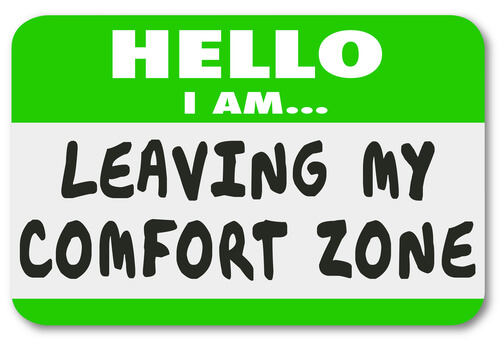Part of leading yourself is learning when to challenge yourself at strategic moments in your professional life. When I look back at my career, several big professional growth spurts were directly attributable to when I pushed my comfort zone. These were times in which I had little or no experience with a particular area or in a certain subject. I had to learn on the fly as I took on and mastered those new projects or responsibilities, a strategy that enabled me to really accelerate my career. That made me a big believer in the importance of periodically pushing your comfort zone. From a professional standpoint, tackling something new has the power to build your capacity for success and is a great discipline worth pursuing.
MAP once worked with a company that was managing two very different business models: (1) low-margin yet dynamic products that consistently got lots of publicity and attention; and (2) boring but high-margin products that garnered little enthusiasm from the company’s leadership and its staff.
As MAP’s consultant was helping the company to identify its Vital Few, everyone realized that as uncomfortable as it made them feel, the company drastically needed to change its resource allocation and start investing heavily in building the lucrative, albeit lackluster division of their business. They all thought it would be super to be “rich and famous” but also agreed that “famous” could—and would have to—wait. The real challenge for everyone was to let go of what was fun and felt comfortable while focusing and building upon this less-riveting yet sturdier business bedrock. In the end, the payoff was huge: just one year later, the company had experienced a seven-figure, bottom-line turnaround.
To push your comfort zone, how do you decide where to start? The structure of this book allows you to review the lessons and determine your Vital Few practices that really stretch your comfort zone and are critical to reaching your leadership potential. How will you know what those are? The vital ones will give you the biggest bang for your buck in self-development, progress, and personal reward. This could include taking on habits tied to areas in which you have very little experience. Or, it might be taking on a new commitment outside your company, something that broadens your experience and opens doors to new connections and professional possibilities.
Once you identify what you want to do or learn, incorporate that into your leadership development plan, so it becomes a real target—a challenge you’re committed to addressing. Then, hold yourself accountable to ensure it happens. Here are some considerations tied to pushing your comfort zone:
View learning as an opportunity to grow confidence. Knowledge is power. The more you know, the more equipped you will be to effectively lead and manage over the course of your career. Not only will you feel more in control, but you’ll also display more confidence because of the prior experience you’ve gained by challenging yourself. When it comes to embracing knowledge and what’s new, people working in the technology industry provide a perfect example for us all. They must have powerful self-initiative and motivational drive, particularly by endlessly innovating to remain cutting edge in their line of work. They can’t fall behind in their field. If they do, it can put their careers, reputations, livelihood, and even their self-esteem at risk.
Trust in the power of learning. Early in my career, I developed a reputation for being someone who was motivated to learn new things and take on difficult assignments. One of the big benefits of this approach was that management noticed I was proactive about my professional growth. They started seeing me as different from some of my peers. As new internal job opportunities opened up, I successfully climbed the corporate ladder.
Likewise, if you are willing to push your comfort zone and learn new things, people will probably recognize your efforts, too. It’s a great way to set yourself apart from others and get ahead more quickly in your career. As people notice, the efforts you’ve made will pay off— perhaps you’ll land that breakthrough client, someone who never gave you the time of day until you took that self-initiative to become smarter or more skilled at business development.
On top of this, your newfound skills and expertise could earn you a better position within your current company or a more challenging, exciting opportunity outside it. Maybe it will pan out in the form of greater financial rewards, a payback that can be particularly satisfying if you’ve personally invested hard-earned dollars, time, or other resources into your self-improvement goal. The benefit might not seem obvious or be immediate, but it will eventually become clear.
A compelling story on trusting in the power of learning comes from the 2005 commencement speech delivered to Stanford University graduates by the late Steve Jobs. In the speech, he explained how his seemingly random decision to take a calligraphy class later contributed to his success in computers. When he and his design team built the first Macintosh, they developed it with the beautiful typography that is now an everyday feature to all computers today. When he first signed up for that class, he was simply doing something he enjoyed. The full benefit of what he learned didn’t become clear until about ten years later in his life—but it certainly did become clear.
Make it fun! If you make the conscientious choice to view your self-improvement—even the professional kind—in a lighthearted, positive way, you can actually enjoy whatever it is you’ve decided to learn. Approach the goal you’ve set with a positive, grateful attitude, and your perception about the goal and the journey will simply feel easier, less like work, and more like fun. View this commitment as something you want to do, not something you have to do, thinking of it in terms of exploring fresh horizons, creating new relationships, pushing exciting personal boundaries, and so forth. When you set a goal to learn something new, actively plan for a way to make the experience enjoyable.
Some years back, I worked at a Fortune 500 company and led a cross-functional team tasked with automating our customer-service system for frontline employees. In doing this, my team and I were way outside our comfort zone mainly because the project was so massive. We experienced a lot of ups and downs. However, throughout the course of the project and even at its most challenging moments, we found ways to make it fun. We would celebrate small wins by going out to different restaurants and recognizing individuals who were making a difference. We also developed a process to acknowledge people who demonstrated commitment to the project, and this became so popular the entire company ended up adopting the recognition process. We rewarded people who contributed to the project’s success in small ways by giving them candy and little gifts, and, to our surprise, people had more fun with the small rather than large incentives. Our approach provided a lot of great laughs (endorphins!) and camaraderie amid the trials and errors of creatively collaborating as a team on such a lofty goal. There are many things in life that aren’t necessarily fun but must be done. So if you’re going to take on something new in your professional development, building up the fun factor will make it more attractive and certainly more doable, too.
In Summary: The Disciplined Leader recognizes pushing the comfort zone can become a fun challenge that makes professional and personal growth more rewarding. Challenging your comfort zone can accelerate and lead to new career opportunities, building your potential to achieve your leadership goals.
Take Action!
- Make a list of things that you want to learn that will push your comfort zone. Incorporate your top picks into your self-development plan.
- Take a class in a relevant field that will push you in new ways and sharpen your skills.
- Seek more responsibility in the areas you want to develop. These areas can be inside or outside of work.




